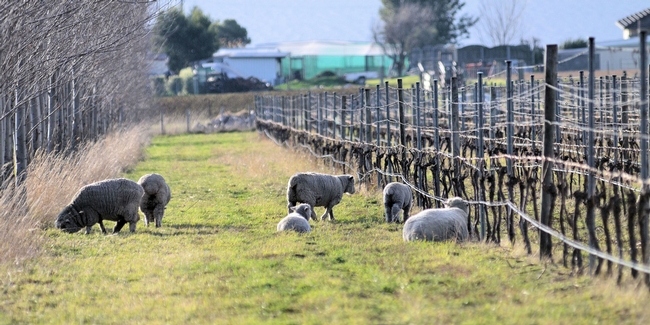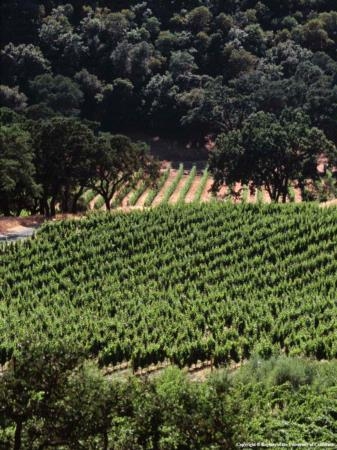Posts Tagged: grapes
On the topic of vineyard nutrient management, farmers want to know about sheep
The UC Sustainable Agriculture Research and Education Program is working to build an online community for growers facing challenges and trying innovative approaches to how they manage nutrients on the farm. With the help of FarmsReach and Sustainable Conservation, we've been working to build up an online group based on nutrient management to discuss a wide array of practices. For two weeks in January, we hosted a discussion on nutrient management for vineyards, particularly in times of drought.
In a recent Capital Public Radio story on winemakers struggling with groundwater shortages this year, winemaker Chris Leamy said “the drought has helped to spur change and innovation.” When business as usual is not an option, farmers get creative. Through discussion, informational videos, and a tool kit of resources, farmers and UC advisors shared some of the creative ways that growers are adapting to water limitations and building healthy soil in their vineyards.
One discussion to rise to the surface throughout was the use of animals in vineyard systems. Farmers with experience running animals through their vineyards chimed in with valuable insights.
Some thoughts repeated by several growers were:
- Short breeds like babydoll sheep and tall cordons on vines make sheep less able to graze on the canopy. Some growers use electrified deterrents running parallel to the trellis to allow sheep to stay in the vineyard into the summer with no leaf damage. Growers who kept sheep in vineyards year round described eliminating mowing completely.
- Drip lines need to be tall enough to be out of reach from sheep.
- Move sheep frequently to prevent soil compaction.
- One grower runs chickens through the vineyard at the end of the season, but says to avoid the practice if shoot growth has been too vigorous — the added nutrients from the chickens may give vines an unwanted boost in the spring.
- Growers who use sheep in their vineyards describe significant nutrient inputs from sheep, some to the point of eliminating other fertilizers altogether.
You can follow more of the conversation here. The group of participants is growing (94 strong now!) and we'll be hosting future discussions on different topics. This project is hosted by UC SAREP as part of the Solution Center for Nutrient Management. You can join our mailing list to stay up-to-date with our activities, online discussions, and updates to our website.
Growing wine grapes without irrigation possible for some, not all
"If you don't water in the San Joaquin Valley, you're not getting a yield," Larry Williams, a professor in the Department of Viticulture and Enology at UC Davis and based at Kearney Agricultural Research and Extension Center, told Pierson.
Last month Sacramento Bee columnist Mike Dunne used Williams' study of water use of chardonnay grapes in the Carneros Region to refute the amount of water a Dutch researcher claimed was required to produce a single glass of wine. “In California vineyards and cellars, is 29 gallons of water to produce a single glass of wine a realistic estimate?” Dunne asked Williams, who explained that California grape yields per gallon of water are much higher than in Europe.
“The mean yield of wine grapes in Europe ... is around 1.8 tons per acre using data I've gleaned from research papers,” Williams says. “The mean chardonnay yields across California are 7.4 tons per acre.”
Based on Williams' research, Dunne wrote, “Vines of the dry-farmed portion yielded 4.9 tons per acre, while vines on the irrigated portion produced 6.3 tons per acre. The upshot was that 14.2 gallons of water was needed in the dry-farmed block to produce a typical 4-ounce pour of wine, while 15.3 gallons of water was needed in the irrigated parcel to produce a 4-ounce pour of wine, totals far lower than the figure calculated by the Water Footprint Network.”
Wine demand expected to rise in US, fall worldwide
Within 20 years, 42,000 acres of new vines could be needed to meet growing U.S. wine consumption, Western Farm Press reported Jim Lapsley, UC Davis professor emeritus of ag economics, said at the “Outlook and Issues for the World Wine Market” symposium sponsored by the UC Agricultural Issues Center in late June.
But recently, cheaper wine imports have been spurring growers to replace grapevines with more profitable crops, notes reporter Harry Cline. In the Central Valley, wine grape plantings declined from 190,000 acres in 2001 to 157,000 in 2008.
“Using UC crop budgets, wine grapes are netting only $80 per acre compared to almonds at $200, walnuts at $1,070, pistachios at $860 and pomegranates at $620,” writes Cline.
“The supply of inexpensive wines from other countries acts as a ceiling on prices for wine grape growers,” Lapsley is quoted saying regarding San Joaquin Valley wine grapes.
Based on population/demographic trends and the falling wine consumption in Italy, France, Spain and Argentina, Dan Sumner, director of the University of California Agricultural Issues Center, expects world wine demand to decline despite projected consumption increases in the U.S., U.K. and Germany.
“World wine markets may still expand as incomes grow gradually in traditional markets and wine consumption is introduced in places with rapid population and income growth,” Sumner is quoted as saying.
European grapevine moth funding for growers
At a press conference in Fresno Wednesday, the Natural Resources Conservation Service announced a $1 million cost sharing program to help combat European grapevine moth in California.
The support will cover half the cost of voluntary, environmentally friendly control options, according to the NRCS press release. The pest control strategies, the release said, were developed and approved for use over the past five years by NRCS and the University of California Cooperative Extension. The cost of the treatment is about $208 per acre; NRCS will provide $104 per acre.
"Our intention is to complement the efforts of our partners at CDFA and USDA APHIS who have both the expertise and authority for overseeing infestations of EGVM," NRCS state conservationist Ed Burton is quoted in the release. "We will provide some very targeted Integrated Pest Management tools to farmers who are growing grapes in close vicinity to trapped moths."
Farmers must apply for the funding by June 23.
The Fresno press conference was covered by a number of media outlets, including:
- The Fresno Bee
- KMPH Channel 26 news (Fox affiliate)
- KFSN Channel 30 news (ABC affiliate)
- CBS Channel 47 news
The press conference came a day after USDA Animal and Plant Health Inspection Service announced it released an additional $1.75 million in Farm Bill funding to stem the spread of European grapevine moth in California.
European grapevine moth in Fresno County
Fresno County Agricultural Commissioner Carol Hafner held a news conference yesterday to outline efforts to combat European grapevine moth after three were detected last week in Fresno County. The ag commissioner's office has been monitoring thousands of traps in the county as part of a statewide program to detect the invasive pest.
On April 28, the officials confirmed that two European grapevine moths were found in separate traps about a half mile apart in vineyards southeast of the city of Fresno. On May 1, one moth was found in a trap in the Kingsburg area.
Grape production is the No. 1 ag industry in Fresno County, with an annual value of more than $700 million. The new threat to the industry posed by European grapevine moth was covered widely by local media, including:
Earlier this week, the Fresno Bee reported that USDA is providing California with an additional $1 million to help fight the spread of the European grapevine moth, now found in five California counties. The federal agency had already allocated $1.7 million to deal with the pest.

Fresno grape industry threated by exotic pest.



